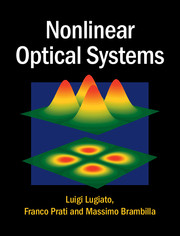Book contents
- Frontmatter
- Dedication
- Contents
- Preface
- Part I Models, propagation, stationary phenomena
- 1 The rate-equation model for the laser
- 2 The interaction of a system of two-level atoms with the electromagnetic field
- 3 The Maxwell–Bloch equations
- 4 Inclusion of the irreversible processes in the atomic equations
- 5 Propagation in irreversible Maxwell–Bloch equations
- 6 Optical nonlinearities. Materials with quadratic nonlinearities
- 7 Optical nonlinearities. Materials with cubic nonlinearities
- 8 Optical resonators. The planar ring cavity. Empty cavity. Linear cavity
- 9 A nonlinear active ring cavity: the ring laser, stationary states
- 10 The adiabatic elimination principle
- 11 A nonlinear passive ring cavity: optical bistability
- 12 Modal equations for the ring cavity. The single-mode model
- 13 Single- and two-mode models
- 14 Nonlinear dynamics in Fabry–Perot cavities
- 15 Inhomogeneous broadening
- 16 The semiconductor laser
- 17 Lasers without inversion and the effects of atomic coherence
- Part II Dynamical Phenomena, Instabilities, Chaos
- Part III Transverse optical patterns
- Appendix A The Routh–Hurwitz stability criterion
- Appendix B Calculation of the oscillatory instability boundary
- Appendix C Coefficients of the characteristic equation (20.20)
- Appendix D Derivation of equations (20.27) and (20.28)
- Appendix E Coefficients of equations (20.60) and (20.61)
- Appendix F The exact boundary of the Risken–Nummedal–Graham–Haken instability
- Appendix G Nonlinear analysis of the roll solution
- References
- Index
16 - The semiconductor laser
from Part I - Models, propagation, stationary phenomena
Published online by Cambridge University Press: 05 March 2015
- Frontmatter
- Dedication
- Contents
- Preface
- Part I Models, propagation, stationary phenomena
- 1 The rate-equation model for the laser
- 2 The interaction of a system of two-level atoms with the electromagnetic field
- 3 The Maxwell–Bloch equations
- 4 Inclusion of the irreversible processes in the atomic equations
- 5 Propagation in irreversible Maxwell–Bloch equations
- 6 Optical nonlinearities. Materials with quadratic nonlinearities
- 7 Optical nonlinearities. Materials with cubic nonlinearities
- 8 Optical resonators. The planar ring cavity. Empty cavity. Linear cavity
- 9 A nonlinear active ring cavity: the ring laser, stationary states
- 10 The adiabatic elimination principle
- 11 A nonlinear passive ring cavity: optical bistability
- 12 Modal equations for the ring cavity. The single-mode model
- 13 Single- and two-mode models
- 14 Nonlinear dynamics in Fabry–Perot cavities
- 15 Inhomogeneous broadening
- 16 The semiconductor laser
- 17 Lasers without inversion and the effects of atomic coherence
- Part II Dynamical Phenomena, Instabilities, Chaos
- Part III Transverse optical patterns
- Appendix A The Routh–Hurwitz stability criterion
- Appendix B Calculation of the oscillatory instability boundary
- Appendix C Coefficients of the characteristic equation (20.20)
- Appendix D Derivation of equations (20.27) and (20.28)
- Appendix E Coefficients of equations (20.60) and (20.61)
- Appendix F The exact boundary of the Risken–Nummedal–Graham–Haken instability
- Appendix G Nonlinear analysis of the roll solution
- References
- Index
Summary
This chapter plays a special role in the economy of this book. In the treatment of nonlinear optical systems such as the laser, we have adopted an idealized theoretical description such as the two-level picture. For any kind of real laser the physics behind it is complex. In order to let the reader appreciate this point and evaluate to what extent the models used in this book can describe such a complex reality, we have chosen the case of one of the lasers which is most commonly utilized in applications, namely the semiconductor laser [153–163], for which the physics is especially rich and interesting. A detailed description of this type of laser is not simple, because a semiconductor material cannot be modeled as a collection of identical atoms with homogeneous broadening. Even if the interaction with the electric field involves electron–hole pairs, each of which can be assimilated to a two-level atom, the picture is complicated by various elements. Owing to the Pauli exclusion principle, there may exist at most two electrons, and two holes, having the same energy, with the factor of 2 arising from the spin degeneracy. As a consequence, different electron–hole pairs correspond to different transition frequencies, and the gain line is inhomogeneously broadened. In addition, the carriers (electrons and holes) interact with the crystalline lattice, and this circumstance leads to a complex band structure of the energy levels. Finally the carriers interact with one another via the Coulomb force, i.e. there is a many-body interaction.
We will focus on a simple model that takes the inhomogeneous broadening into account, considers the simplest possible structure for the bands and, among the effects of the many-body interaction, includes only, in a phenomenological way, the so-called band-gap renormalization, i.e. the progressive reduction of the transition frequency when the carrier number increases.
- Type
- Chapter
- Information
- Nonlinear Optical Systems , pp. 177 - 191Publisher: Cambridge University PressPrint publication year: 2015



